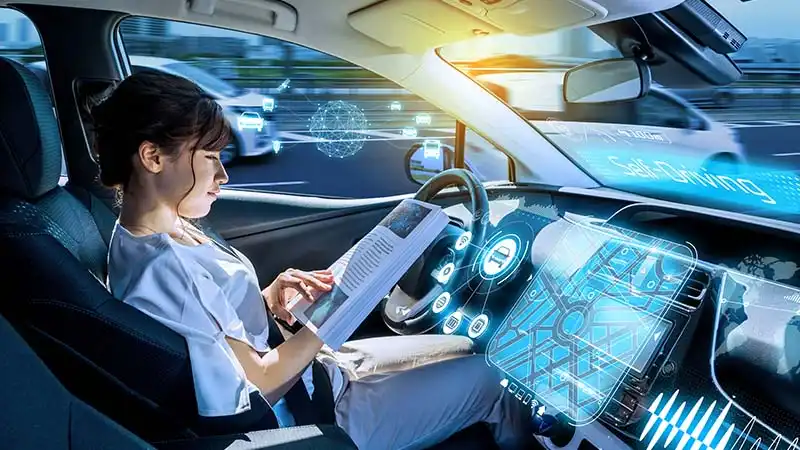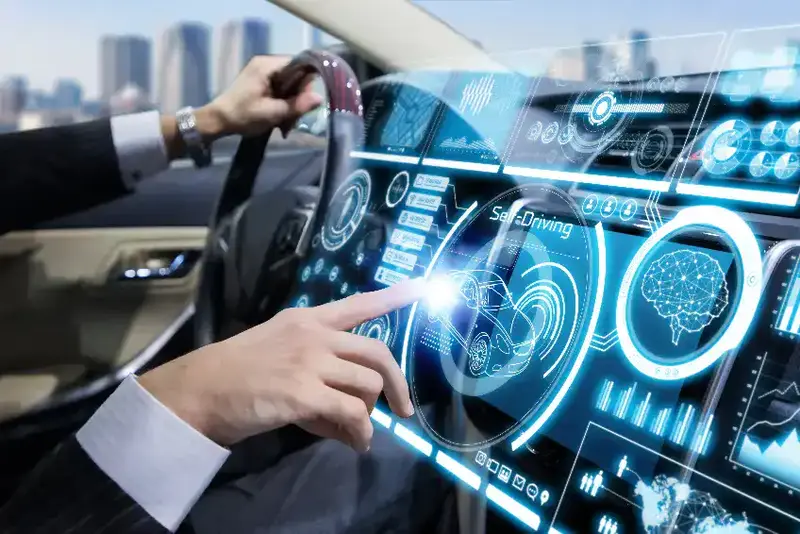
Automotive technology refers to the various technologies, systems, and processes used in the design, manufacturing, and operation of automobiles. It includes everything from the engine and transmission to the brakes, suspension, and infotainment systems. With the advancements in technology, the automotive industry has undergone significant changes over the years, transforming the way we travel and interact with our vehicles. This section will provide an overview of automotive technology’s key concepts and components.
Evolution of Automotive Technology
The evolution of automotive technology spans over more than a century, starting from the invention of the first gasoline-powered vehicle in the late 19th century to the latest electric and self-driving cars of today. Here are some key milestones in the history of automotive technology:
- Invention of the Internal Combustion Engine: In 1876, Nikolaus Otto invented the four-stroke internal combustion engine, which revolutionized the automotive industry.
- Ford Model T: In 1908, Henry Ford introduced the Model T, which was the first affordable car for the masses.
- Electronic Ignition: In the 1970s, electronic ignition systems replaced the traditional mechanical systems, resulting in more efficient and reliable engines.
- Anti-lock Braking Systems (ABS): In the 1980s, ABS systems were introduced, which prevented the wheels from locking up during sudden braking, thereby improving the control and stability of the vehicle.
- Hybrid Vehicles: In the 1990s, hybrid vehicles were developed, which combined gasoline and electric power to increase fuel efficiency and reduce emissions.
- Autonomous Vehicles: In recent years, self-driving or autonomous vehicles have been developed, which use advanced sensors and software to operate without human intervention.

Current State of Automotive Technology
The current state of automotive technology is characterized by rapid advancements in several areas, including:
- Electric Vehicles (EVs): With the increasing focus on sustainability and reducing carbon emissions, EVs are becoming more mainstream. Several major automakers have launched or are planning to launch a range of electric vehicles, and there is a growing network of charging stations to support them.
- Advanced Driver Assistance Systems (ADAS): ADAS technologies, such as automatic emergency braking, lane departure warning, and adaptive cruise control, are becoming standard features in many vehicles. These systems help improve safety and reduce the risk of accidents.
- Connectivity: Modern cars are increasingly connected, with features such as infotainment systems, Bluetooth connectivity, and internet access. This connectivity also enables remote diagnostics and over-the-air software updates.
- Lightweight Materials: Lightweight materials, such as aluminum and carbon fiber, are being used in the design and manufacturing of vehicles to improve fuel efficiency and reduce emissions.
- Autonomous Vehicles: While fully autonomous vehicles are not yet widely available, the development and testing of self-driving cars are progressing rapidly. This technology has the potential to revolutionize the way we travel, with improved safety, convenience, and efficiency.
See also Everything You Need To Know About Glass Railing Installers
Key Advancements in Automotive Technology
There have been numerous advancements in automotive technology in recent years, leading to significant improvements in the performance, safety, and sustainability of vehicles. Here are some of the key advancements in automotive technology:
- Electric Powertrains: Electric powertrains have become increasingly advanced, allowing for longer range and faster charging times. In addition, the development of solid-state batteries holds the promise of even greater improvements in the future.
- Autonomous Driving: Advances in sensors, cameras, and artificial intelligence have enabled the development of autonomous driving technology. This has the potential to reduce accidents, congestion, and energy use, and improve mobility for people who cannot drive, such as the elderly and disabled.
- Advanced Driver Assistance Systems (ADAS): ADAS features, such as automatic emergency braking, adaptive cruise control, and lane-keeping assistance, are becoming more common and effective. These systems help improve safety and reduce the risk of accidents.
- Lightweight Materials: The use of lightweight materials, such as aluminum and carbon fiber, has allowed for improved fuel efficiency without sacrificing performance or safety.
- Connectivity: Vehicles are becoming increasingly connected, with features such as infotainment systems, GPS, and real-time traffic data. This connectivity also enables remote diagnostics and over-the-air software updates.
- Advanced Manufacturing Techniques: Advances in manufacturing, such as 3D printing and robotics, are allowing for greater precision and efficiency in the production of vehicles and their components.
Automotive Technology and the Environment
The automotive industry has a significant impact on the environment, and automotive technology has the potential to both contribute to and mitigate this impact. Here are some ways in which automotive technology is affecting the environment:
- Emissions Reduction: The use of electric and hybrid powertrains, as well as advanced combustion engines, is reducing emissions of pollutants such as carbon dioxide, nitrogen oxides, and particulate matter. This helps to improve air quality and mitigate climate change.
- Lightweight Materials: The use of lightweight materials such as aluminum and carbon fiber reduces the weight of vehicles, leading to improved fuel efficiency and lower emissions.
- Recycling and Reuse: Automotive manufacturers increasingly use recycled materials and design vehicles with recyclability in mind. This helps to reduce waste and conserve natural resources.
- Sustainable Manufacturing: Automakers are implementing more sustainable manufacturing practices, such as using renewable energy sources and reducing water use and waste.
- End-of-Life Management: Automakers are developing processes for the responsible disposal of end-of-life vehicles.
See also A closer look at Club 4: What makes it the ultimate lifestyle club?

Future of Automotive Technology
The future of automotive technology is likely to be characterized by even more significant advancements in areas such as:
- Electric and Hydrogen Vehicles: The transition to electric and hydrogen vehicles is expected to continue, with increasing ranges and faster charging times. These vehicles are likely to become more affordable, and the infrastructure for charging and refueling is expected to expand.
- Autonomous Driving: The development of autonomous driving technology is likely to accelerate, with the potential for fully autonomous vehicles to become more common on the roads. This technology is expected to improve safety, reduce congestion, and improve the efficiency of transportation.
- Connectivity and Digitalization: Vehicles are becoming more connected, with the integration of features such as 5G, artificial intelligence, and augmented reality. This connectivity is likely to transform the way people use and interact with their vehicles.
- Advanced Materials: Lightweight materials such as graphene, which are stronger and lighter than existing materials, may be increasingly used in the construction of vehicles.
- Sustainable Manufacturing: Automakers are expected to continue to adopt more sustainable manufacturing practices, such as reducing waste, using renewable energy sources, and increasing recycling and reuse.
- Personalization and Mobility Services: Advances in technology are expected to enable greater personalization of vehicles, with the potential for shared ownership and new mobility services to become more common.
Impact of Automotive Technology on Society
Automotive technology has had a significant impact on society, both positive and negative. Here are some of the ways in which automotive technology has influenced society:
- Increased Mobility: The ability to travel long distances quickly and easily has brought about greater freedom and opportunities for people. This has enabled people to live and work in different locations, and to access a wider range of goods and services.
- Economic Growth: The automotive industry is a major contributor to economic growth, providing jobs and generating revenue for governments. In addition, the ability to travel easily and quickly has facilitated the growth of trade and commerce.
- Environmental Impact: The automotive industry has a significant impact on the environment, contributing to air and water pollution, climate change, and the depletion of natural resources. However, advances in automotive technology, such as electric powertrains and lightweight materials, are helping to mitigate these impacts.
- Safety: Automotive technology has significantly improved the safety of vehicles and reduced the risk of accidents. Features such as seat belts, airbags, and advanced driver assistance systems are helping to reduce injuries and fatalities on the roads.
- Social Cohesion: The ability to travel has brought people from different regions and cultures together, facilitating social cohesion and cross-cultural exchange.
- Urbanization: The automobile has contributed to the growth of cities and the development of urban infrastructure such as highways and parking facilities. However, this has also led to urban sprawl and increased congestion, leading to negative environmental and social impacts.
See also Custom Outdoor Sofas Dubai
Conclusion
Automotive technology has come a long way since the invention of the automobile, and continues to advance at a rapid pace. From electric and hybrid powertrains to autonomous driving and advanced materials, the future of automotive technology is set to bring about even more significant changes in the way people travel.
While automotive technology has brought about significant benefits, such as increased mobility, economic growth, and improved safety, it has also had negative impacts on the environment and society, such as air pollution, congestion, and urban sprawl. However, continued innovation and regulation can help to mitigate these impacts, and ensure that the benefits of automotive technology continue to outweigh the costs.
Overall, automotive technology has revolutionized the way people travel, and has the potential to bring about even greater benefits in the future, such as more efficient and sustainable vehicles, improved safety, and enhanced connectivity.
